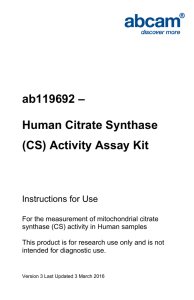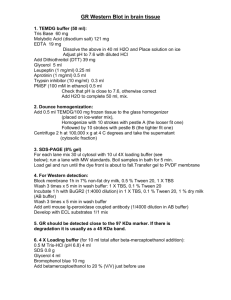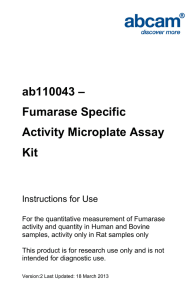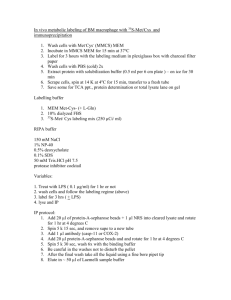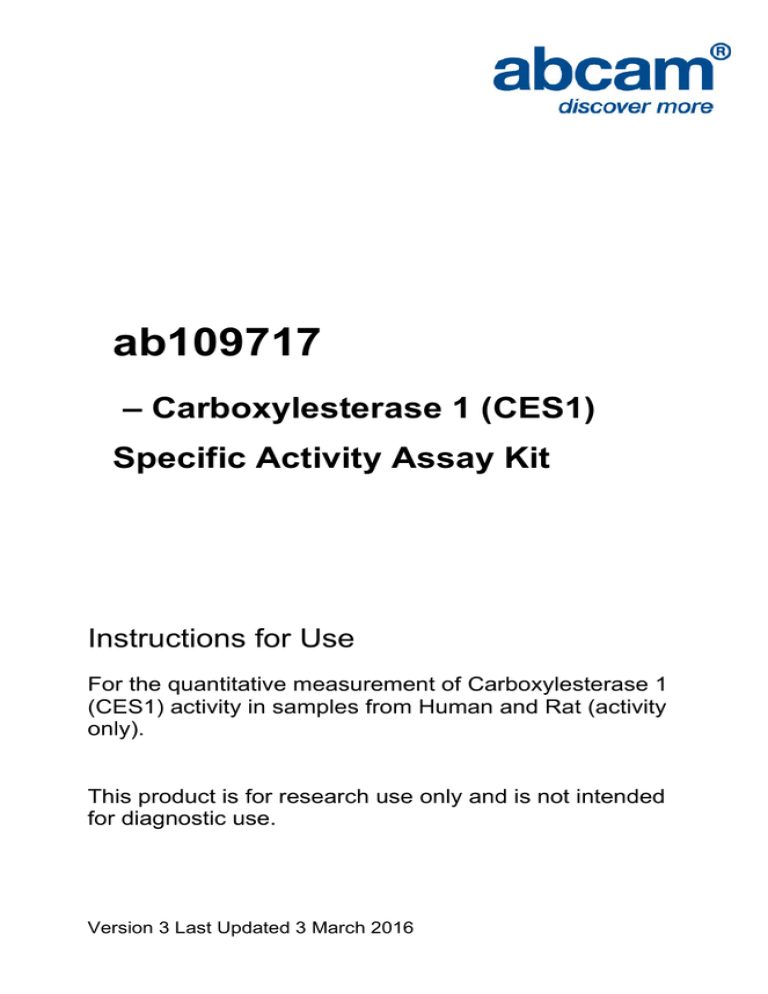
ab109717
– Carboxylesterase 1 (CES1)
Specific Activity Assay Kit
Instructions for Use
For the quantitative measurement of Carboxylesterase 1
(CES1) activity in samples from Human and Rat (activity
only).
This product is for research use only and is not intended
for diagnostic use.
Version 3 Last Updated 3 March 2016
1
Table of Contents
1.
Introduction
3
2.
Assay Summary
5
3.
Kit Contents
7
4.
Storage and Handling
8
5.
Additional Materials Required
8
6.
Preparation of Buffers and Samples
9
7
Assay Method
11
8
Data Analysis
13
9
Specificity
19
10 Troubleshooting
20
2
1. Introduction
Abcam’s enzyme activity assays apply a novel approach, whereby
target enzymes are first immunocaptured from tissue or cell samples
before subsequent functional analysis. All of our ELISA kits utilize
highly validated monoclonal antibodies and proprietary buffers,
which are able to capture even very large enzyme complexes in their
fully-intact, functionally-active states.
Capture antibodies are pre-coated in the wells of premium Nunc
MaxiSorp™ modular microplates, which can be broken into 8-well
strips. After the target has been immobilized in the well, substrate is
added, and enzyme activity is analyzed by measuring the change in
absorbance of either the substrate or the product of the reaction
(depending upon which enzyme is being analyzed). By analyzing the
enzyme's activity in an isolated context, outside of the cell and free
from any other variables, an accurate measurement of the enzyme's
functional state can be understood.
Carboxylesterase 1 (CES1, P23141) is a 61 kDa serine hydrolase
family enzyme that catalyzes the hydrolysis of an ester into an
alcohol and an acid (EC 3.1.1.1) in the liver cell endoplasmic
reticulum
lumen.
Carboxylesterases
have
broad
overlapping
specificity, this promiscuity is due to a large conformable active site.
Many environmental toxicants, therapeutic and illicit drugs are
esterified.
Therefore
carboxylesterases
are
involved
in
the
detoxification of a number of different xenobiotics and in the
activation of ester and amide prodrugs. Therefore carboxylesterases
play a major role as determinants of pharmacokinetic behavior for
3
most therapeutic agents containing an ester. There is also growing
appreciation of the role of carboxylesterases in the processing of
endobiotics,
including
cholesterol
esters
and
triacylglycerol.
cholesterol esters and triacylglycerol.
ab109717 (MS789) improves upon conventional CES1 activity
assays in two ways. First, this assay immunocaptures in each well
only native CES1 from the chosen liver sample or liver derived cell
line; this removes all other enzymes. Second, after activity
measurement, in the same well/s, the quantity of enzyme is
measured by adding a second CES1 specific antibody which is
detected by a colorimetric label (HRP). This reaction takes place in a
time dependant manner proportional to the amount of enzyme
captured in each well. By combining activity and quantity
measurements, the relative specific activity can be determined.
Specific activity is a useful for measuring up or down regulation of
activity by site-specific modification or damage.
4
2. Assay Summary
Prepare sample (approximately 1 hour)
Extract the sample pellet
Incubate on ice for 20 minutes.
Centrifuge at 12000 x g for 20 minutes and then collect
supernatant.
Determine protein concentration and dilute to within
recommendation range
Load plate (2-3 hours)
Load sample(s) on the plate being sure to include a dilution
series of a reference or normal sample and a buffer control as
null reference.
Incubate 2 hrs at room temperature
Activity measurement (1 hour)
Empty wells and wash each well twice with 300 μl 1X Wash
Buffer.
Prepare activity solution
Measure activity in a standard microplate reader for up to 10-60
mins OD402
5
Detector antibody incubation (1 hour)
Empty wells and wash each well twice with 300 μl 1X Wash
Buffer.
Add 100 μl of 1X Detector antibody to every well used.
Incubate for 30 mins at room temperature.
HRP label incubation (1 hour)
Empty wells and wash each well twice with 300 μl 1X Wash
Buffer.
Add 100 μl of 1X HRP Label to every well used.
Incubate for 30 mins at room temperature
Quantity measurement (15 min)
Empty wells, wash each four times with 300 μl 1X Wash Buffer.
Add 100 μl of Development Solution.
Measure OD600 at 20-second intervals for 15 minutes at room
temperature.
6
3. Kit Contents
Sufficient materials are provided for 96 measurements in a
microplate.
Item
Quantity
5700X 4-nitrophenol (5.7 M)
20 µL
Extraction Buffer
15 ml
Buffer
25 ml
10X Blocking Solution
10 ml
1X Development Solution
12 ml
1X Base Buffer
25 ml
100X Detector Antibody
125 µL
100X HRP Label
125 µL
CES1 Microplate (12 x 8 antibody coated well strips)
96 Wells
7
4. Storage and Handling
Store all components at 4°C. This kit is stable for 6 months from
receipt. Unused microplate strips should be returned to the pouch
containing the desiccant and resealed.
5. Additional Materials Required
Standard absorbance microplate reader, Activity (402 nm),
Quantity (450, 600, or 650 nm)
Multichannel pipette (50 - 300 μl) and tips
1.5 mL microtubes
A fine needle
Optional 1N HCl
8
6. Preparation of Buffers and Samples
Note: This protocol contains detailed steps for measuring CES1
activity in human samples. Be completely familiar with the
protocol before beginning the assay. Do not deviate from the
specified protocol steps or optimal results may not be obtained.
6.1 Preparation of buffers
6.1.1
Prepare 1X Wash Buffer by adding 25 ml Buffer to
475 ml nanopure water.
6.1.2
Prepare 1X Incubation Buffer by adding 10 ml 10X
Blocking Solution to 90 mL 1X Wash Buffer.
6.1.3
Before use prepare 1X Activity Solution. For an entire
plate add 4.4 µl 5700X 4-nitrophenyl butyrate to 25 ml
1X Base Buffer provided.
Note – the final concentration of substrate is now 1 mM 4NPB.NPB can be used at greater dilution to achieve lower
substrate concentration if desired for example when used in a
competitiveassay.
6.1.4
Before use prepare 1X Detector Antibody. For an entire
plate add 125 µL 100X Detector Antibody to 12.375 ml
1X Incubation Buffer.
6.1.5
Before use prepare 1X HRP Label. For an entire plate
add 125 µL 100X HRP Label to 12.375 ml 1X Incubation
Buffer.
9
6.2 Sample Prepapration
Note: Samples must be detergent extracted by the provided
Extraction
buffer.
To
do
this
tissue
homogenates,
microsomal preparations or cell pellets must be prepared.
6.2.1
For cultured cells, microsomal preparations or tissue
homogenates: Pellet the sample by centrifugation and
resuspend the pellet in 9 volumes of Sample Extraction
Buffer. A total of 15 ml 1X Extraction buffer is provided.
Example - for analyses of multiple samples this is
enough to extract 15 samples in 1 ml, 30 in 0.5 ml, 60 in
0.25 ml etc.
6.2.2
Incubate extracts on ice for 20 minutes. Centrifuge
12,000 x g, 4°C, for 20 minutes. Remove the
supernatant and discard the pellet.
6.2.3
Determine the protein concentration of the supernatant
extract (a protein assay method unaffected by the
presence of detergent is critical e.g. BCA assay
recommended).
6.2.4
The sample should be diluted to within the working
range of the assay as described in Assay Method Step
A1 and first consulting Table I. Undiluted extract can be
frozen at -80°C.
10
7 Assay Method
7.1 Activity Measurement
7.1.1
Detergent extracted samples should be diluted in 1X
Incubation Buffer. A dilution series of samples is
recommended to ensure that samples are within the
working range of the activity and the quantity assays.
Also include a buffer control (1X Incubation Buffer only)
as a null or background reference. Add 100 μl of each
diluted sample into individual wells.
7.1.2
Cover/seal the plate and incubate for 2 hours at room
temperature with shaking.
7.1.3
Wash the plate
7.1.3.1 Empty the wells by turning the plate over a receptacle
and firmly shaking out the well contents in one rapid
downward motion. Dispose of biological samples
appropriately.
7.1.3.4 Rapidly add 300 μl 1X Wash Buffer to each well. The
wells must not become dry during any step. Repeat this
wash once more for a total of two washes. After the last
wash strike the microplate surface onto paper towels to
remove excess liquid.
7.1.4
Gently add 200 l 1X Activity Solution to each well
minimizing the production of bubbles.
7.1.5
Pop any bubbles immediately and record absorbance
in the microplate reader prepared as follows:
11
Mode
Wavelength
Time
Interval
Shaking
Kinetic
402 nm
10 min – 1 hr (as desired)
20 sec -1 min
Shake between readings
Alternative– In place of a kinetic reading, at a user defined
time/s record the OD 402 nm in all wells. Record the data for
analysis and proceed to section B – Quantity Measurement.
7.2 Quantity Measurement
7.2.1
Repeat the wash procedure in Assay Method Step A3.
Collect and dispose of solutions and any added
enzyme inhibitors appropriately.
7.2.2
Add 100 μl of 1X Detector Antibody to each well used.
Cover/seal the plate and incubate for 30 minutes at
room temperature with shaking.
7.2.3
Repeat the wash procedure in step Assay Method
Step A3.
7.2.4
Add 100 μl of 1X HRP Label to each well used.
Cover/seal the plate and incubate 30 minutes at room
temperature with shaking. Meanwhile, prepare the
microplate spectrophotometer using the parameters
described below (Step 6).
7.2.5
Repeat the wash procedure in step Assay Method
Step A3 however performing a total of four washes.
12
7.2.6
Add 100 μl HRP Development Solution to each empty
well, rapidly pop bubbles, and immediately record the
blue color development in the microplate reader
prepared as follows:
Mode
Wavelength
Time
Interval
Shaking
Kinetic
600 nm
Up to 15 min
20 sec -1 min
Shake between readings
Alternative – In place of a kinetic reading, at a user defined time
record the endpoint OD data at 600 nm or 450 nm. The reaction
can be stopped by adding 50 μl stop solution (1N HCl) to each
well and record the OD at 450 nm - however an intense, subsaturated, blue color could become saturating by stopping the
reaction and measuring at 450nm. Record the data and proceed
to Data Analysis
8 Data Analysis
Two example data sets are shown in Figure 1 illustrating data
manipulation and analysis of CES1 activity/quantity measurements
in an example human cell line – liver derived HepG2 cells.
Determine the relative activity and quantity of an unknown sample by
first creating standard curves for the reference sample.
13
The following two-fold dilution series of HepG2 cell extract was
prepared in incubation buffer:
0, 1, 2, 4, 8, 16, 32, 64, 125, 250, 500, 1000 μg /ml of cell extract
Activity and quantity data were sequentially collected as described in
this protocol using a microplate reader. Standard curves of these
reference sample data were prepared using the microplate reader
software which is capable of a 4-parameter data analysis (shown
below). Activity and quantity are clearly measurable in the 10500 μg/ ml range when such a fit was applied (alternatively raw data
can be exported to Graph Pad Prism or other graphing software).
14
Figure 1. Unknown samples are interpolated from these reference sample
graphs. By doing this for activity, the amount of reference sample required to
generate the same amount of activity as the unknown sample is determined.
This ratio (or %) of amount of unknown sample: reference sample is the
relative activity. Similarly this is performed to determine the relative quantity
in an unknown sample. Together these numbers identify any alteration in the
activity and or in the quantity of CES1 of an unknown sample.
15
Figure 2. The ratio of the determined activity and quantity gives the relative
specific activity. An increase or decrease in this ratio indicates an increase
or decrease in the specific activity of CES1. In this example, the ratio of the
raw quantity and activity data measured for each dilution point of reference
sample has a clear linear relationship.
8.1
Determination of effect (IC50) of Inhibitors on CES1
activity.
CES1 metabolizes many drugs and is also a well known enzyme for
off-target inhibition by drugs. Frequently recombinant human CES1
is used as the enzyme for in vitro assessment of drug interaction and
inhibition. Here we compare the results found in two studies with
data generated using this assay.
Procedure: a normal human HepG2 lysate was applied to each
microplate well at 6.25g / well i.e. 62.5 g/ml. Meanwhile using the
supplied 12-channel reagent reservoir the following three-fold
dilution series of each inhibitor was prepared in Activity solution: 0,
0.02,, 0.05, 0.14, 0.4, 1.2, 3.7, 11, 33, 100 μM After two hour sample
16
incubation, wells were washed according to the protocol and the
above inhibitor series, in activity solution, was added to the plate
using a 12 channel pipette. Activity rate was measured over a 10
minute period.
Results:
Example 1 - Bencharit et al. Chem Biol 2003; 10(4) 341-9
Tacrine (9-amino-1,2,3,4-tetrahydroacridine) was the first drug
approved to treat the symptoms of Alzheimer’s disease. Tacrine is
an inhibitor of acetylcholinesterases (serine hydrolase enzymes
related to the carboxylesterases). Tacrine was shown in the above
study to co-crystalize in the active site of human recombinant CES1
but was not found to inhibit the enzyme due to the large size of the
active site. In agreement with this study, tacrine did not significantly
inhibit CES1 activity in this assay (Figure 3A).
Example 2 - Fukami et al. Drug Metab Dispos 2010; 38(12):21738
17
Thiazolidinediones (TZD) are a class of antidiabetic drugs which act
by binding to peroxisome proliferator activated receptors (specifically
PPAR). The three principle TZDs are troglitazone, pioglitazone and
rosiglitazone. In this study, only troglitazone demonstrated a
significant
inhibition
of
CES1
at
relevant
(i.e.
bioavailable)
concentrations (IC50 5.6 M).
Using this assay, these TZDs were also shown to inhibit CES1 and
in the same order of significance: pioglitazone (IC50 >100 M),
rosiglitazone (IC50 >100 M) and troglitazone (IC50 3 M) (Figure
3B).
8.2
Reproducibility
Typical intra-assay (well-well) variations (same sample) <6% (n=8)
Typical inter-assay (plate-plate) variation (same sample) <11% (n=8)
18
9 Specificity
Species Reactivity: Human and Rat (activity only).
This assay has been demonstrated with human liver tissue samples
and HepG2, a liver derived human cultured cell line. Typical ranges
for several sample types are described below. It is highly
recommended to prepare multiple dilutions for each sample to
ensure that each is in the working range of the assay (see Data
Analysis section).
Table 1: Typical working ranges for activity and quantity of samples
in µg/ml (Note however the assay requires 100 µl sample in each
well):
Sample Type
Range
Cultured Human whole cell extracts (HepG2)
10 μg -500 μg/ml
Human liver tissue extract
1 μg - 50 μg/ml
Rat Liver extract (activity only)
10 μg -500 μg/ml
19
10 Troubleshooting
Problem
Poor standard
curve
Cause
Solution
Inaccurate Pipetting
Check pipettes
Improper standard
dilution
Prior to opening, briefly spin
the stock standard tube and
dissolve the powder
thoroughly by gentle mixing
Incubation times too
brief
Ensure sufficient incubation
times; change to overnight
standard/sample incubation
Inadequate reagent
volumes or improper
dilution
Check pipettes and ensure
correct preparation
Plate is insufficiently
washed
Review manual for proper
wash technique. If using a
plate washer, check all ports
for obstructions
Contaminated wash
buffer
Prepare fresh wash buffer
Improper storage of
the ELISA kit
Store the reconstituted
protein at -80°C, all other
assay components at 4°C.
Keep substrate solution
protected from light.
Low Signal
Large CV
Low sensitivity
20
21
22
UK, EU and ROW
Email: technical@abcam.com
Tel: +44 (0)1223 696000
www.abcam.com
US, Canada and Latin America
Email: us.technical@abcam.com
Tel: 888-77-ABCAM (22226)
www.abcam.com
China and Asia Pacific
Email: hk.technical@abcam.com
Tel: 108008523689 (中國聯通)
www.abcam.cn
Japan
Email: technical@abcam.co.jp
Tel: +81-(0)3-6231-0940
www.abcam.co.jp
Copyright © 2012 Abcam, All Rights Reserved. The Abcam logo is a registered trademark.
All information / detail is correct at time of going to print.
23


